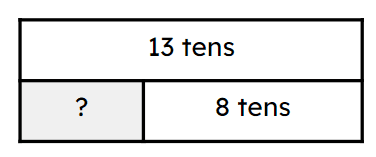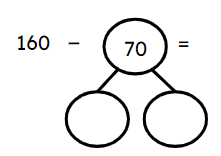Myths about teaching can hold you back
- Year 3
Bridge 100 by subtracting in multiples of 10
I can use number facts to 20 to subtract multiples of 10 and bridge 100.
- Year 3
Bridge 100 by subtracting in multiples of 10
I can use number facts to 20 to subtract multiples of 10 and bridge 100.
These resources will be removed by end of Summer Term 2025.
Switch to our new teaching resources now - designed by teachers and leading subject experts, and tested in classrooms.
These resources were created for remote use during the pandemic and are not designed for classroom teaching.
Lesson details
Key learning points
- The language of unitising helps us to use number facts to 20 to subtract multiples of 10 crossing the hundreds.
- If 14 subtract 6 is equal to 8 then 14 tens subtract 6 tens is equal to 8 tens or 80.
- Partitioning the subtrahend helps us to cross the 100s boundary.
Keywords
Subtrahend - The number that is to be subtracted. The second number in a subtraction.
Minuend - The first number in a subtraction. The number from which another number is to be subtracted.
Common misconception
Lack of fluency with number facts to 20 can hinder progress in applying them to multiples of ten.
Ensure that fluency with number facts to 20 and related subtraction facts is secure or supported so that pupils can apply them.
To help you plan your year 3 maths lesson on: Bridge 100 by subtracting in multiples of 10, download all teaching resources for free and adapt to suit your pupils' needs...
To help you plan your year 3 maths lesson on: Bridge 100 by subtracting in multiples of 10, download all teaching resources for free and adapt to suit your pupils' needs.
The starter quiz will activate and check your pupils' prior knowledge, with versions available both with and without answers in PDF format.
We use learning cycles to break down learning into key concepts or ideas linked to the learning outcome. Each learning cycle features explanations with checks for understanding and practice tasks with feedback. All of this is found in our slide decks, ready for you to download and edit. The practice tasks are also available as printable worksheets and some lessons have additional materials with extra material you might need for teaching the lesson.
The assessment exit quiz will test your pupils' understanding of the key learning points.
Our video is a tool for planning, showing how other teachers might teach the lesson, offering helpful tips, modelled explanations and inspiration for your own delivery in the classroom. Plus, you can set it as homework or revision for pupils and keep their learning on track by sharing an online pupil version of this lesson.
Explore more key stage 2 maths lessons from the Securing place value to 100 and applying to addition and subtraction unit, dive into the full primary maths curriculum, or learn more about lesson planning.

Licence
Prior knowledge starter quiz
6 Questions
Q1.What is the missing value? 8 tens + tens = 13 tens.

Q2.What are the addends in this calculation: 90 + 30 + 10 = 130
Q3.If I know 6 + 7 = 13, what is 6 tens + 7 tens?
Q4.Match the linked equations. Which number facts would you use to solve each equation with multiples of 10?
30 + 80 = 110
40 + 90 = 130
50 + 70 = 120
60 + 70 = 130
Q5. What is the sum of these addends 40 + 60 + 50 =
Q6. What is the missing addend 80 + + 40 = 140?
Assessment exit quiz
6 Questions
Q1.Which number is the subtrahend in this calculation? 150 - 70 = 80
Q2.Which number is the minuend in this calculation? 130 − 50 = 8 tens
Q3.Match the known number fact to its related multiple of ten.
150 - 90 = 60
140 - 60 = 80
130 - 60 = 70
120 - 50 = 70
160 - 80 = 80
Q4.Calculate 120 - = 80
Q5.Which partitioned subtrahend will help you to bridge 100?
50 = 10 + 40
50 = 20 + 30
50 = 30 + 20
50 = 40 + 10
Q6.How would the subtrahend 70 be partitioned in this equation?



